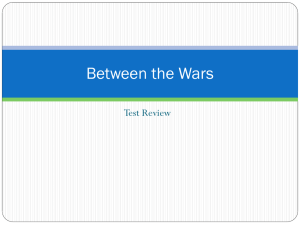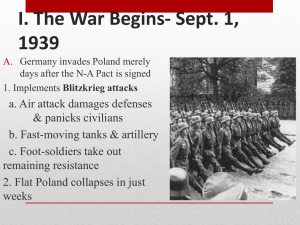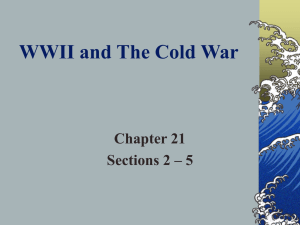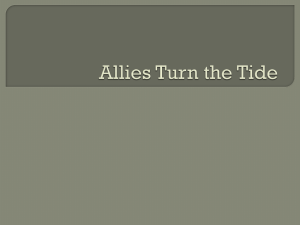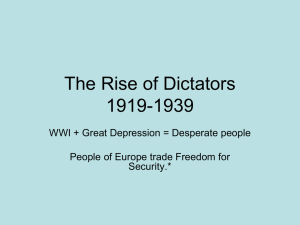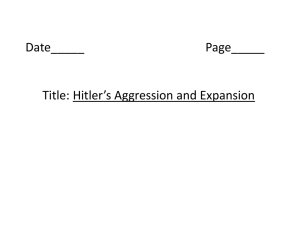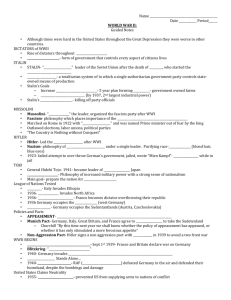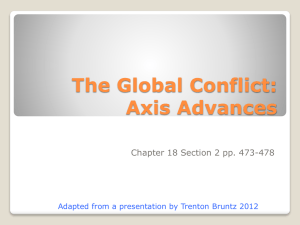Chapter 26: World War II
advertisement
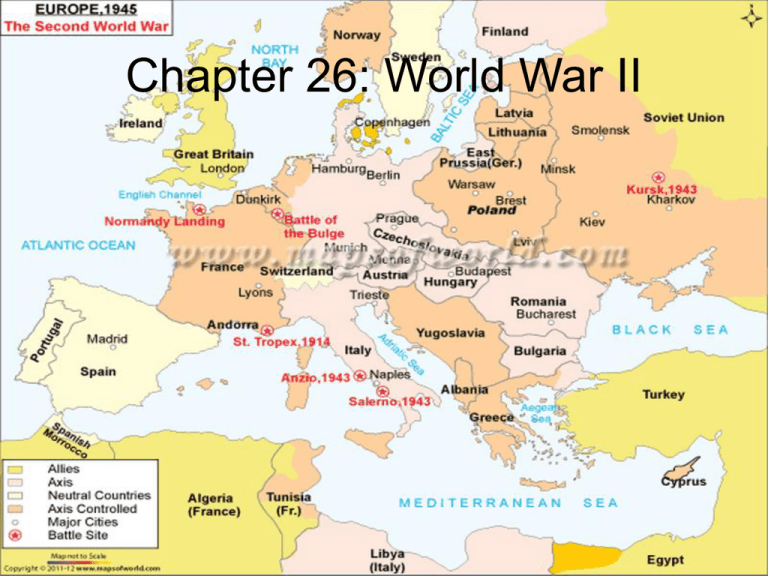
Chapter 26: World War II The Rise of the Dictators 1. Adolph Hitler in Germany 2. Benito Mussolini in Italy 3. Joseph Stalin in the Soviet Union 4. The people of Europe are suffering from the effects of the world wide depression. 5. Germans also are paying back war debt from WWI. 6. Europeans easily accept new leadership that promises hope for the future. 7. Mussolini takes power and bans all opposing parties except his Fascist Party. 8. Mussolini sends boys and girls to military institutions to teach them to be loyal to the government. 9. Hitler’s Nazi Party takes power in Germany 10. Fascists and Nazis are nationalistic and racist, especially toward Jews 11. Racism toward Jews is called antiSemitism. 12. In Japan, military leaders take over. 13. Italy invades Ethiopia. Germany invades the Rhineland, and Japan invades China in hopes of expanding their territory. 14. Japan, Italy, and Germany sign a pact of alliance in 1940 known as the Axis. 15. Stalin demanded complete obedience from his people and used force to get it. 16. These European dictators established Totalitarian states, areas where one man or party control all aspects of life. 17. Stalin forced millions of his people onto government owned farms. 18. America, still suffering from WWI involvement and the Depression, passes the Neutrality Acts, a series of laws created to keep America out of future wars. 19. After invading the Rhineland, Germany invades Austria, the Sudetenland in Czechoslovakia 20. To avoid another world war, Britain and France agree to give Sudetenland to Germany in a policy known as appeasement. 21. Later that year Hitler invades the rest of Czechoslovakia 22. Hitler signs a Non-Aggression pact with Stalin, basically a promise that the two have no plans to attack each other. 23. Hitler then invades Poland. Section 2: War Begins 24. In 1939, with the German invasion of Poland, France and Great Britain declare war on Germany 25. The rapid German attack was known as blitzkrieg, or lightning war. 26. As a result of the Soviet-German pact, Stalin and Hitler divided Poland. 27. The Soviets, although not part of the Axis powers, then forced Latvia, Lithuania, Estonia, and Finland under Soviet control. 28. Germany then invaded Denmark, Norway, the Netherlands and Belgium, all crushed under the German military. 29. Allied troops retreated to the port of Dunkirk on the English Channel. 30. Germans then completed their march by capturing Paris and accepting the French surrender. 31. Hitler attacked Britain by bombing the shipyards, industry, and cities. 32. Hitler asked British Prime Minister Winston Churchill to surrender but Churchill held out. 33. Germany could not gain control of the skies over Britain so Hitler ended his air attacks. 34. Frustrated over Britain, Hitler launched an attack against Stalin in 1941, bringing the Soviets into the war on the side of the Allies. 35. Although neutral, Americans prepared for war. 36. Roosevelt strengthened the navy and enacted the first peace-time draft in American history. 37. Franklin Roosevelt also broke the tradition set by George Washington by running for a third term as President. 38. FDR won by promising that American Boys would not be sent into foreign wars. 39. America passed the Lend-Lease Act, allowing the U.S. to sell, lend, or lease war supplies to any nation considered vital to American defense. 40. American ships began escorting these shipments as German subs started sinking them. 41. America remained neutral and called for disarmament – giving up military weapons. 42. When Germany defeated France, Japan took over the French colony of Indochina and planned to take the Dutch East Indies, Malaya, and the American territory of the Philippines. 43. America responded by freezing all Japanese assets in the United States. 44. Japan negotiated in Washington while secretly planning to go to war with America. 45. At 7:55 a.m. on Sunday, December 7, 1941, Japanese planes attacked the U.S. naval station at Pearl Harbor, Hawaii. 46. On December 11, Germany and Italy declared war on America and America responded by declaring war on the Axis powers. Section 3: America Joins the War 47. Nearly 15 million Americans join the war effort as draftees and volunteers. 48. 250,000 women joined the service as WACs, Women’s Air Corps. Although they did not fight in combat they served vital roles. 49. America paid for the war by raising taxes and selling war bonds. 50. Industry for the war effort soared in America, bringing America back to prosperity after years of depression. 51. Women at home entered the factories as welders and riveters making tanks and planes, although they were paid less than the men. 52. African Americans served at first in segregated units and were gradually integrated with white units in non-combat roles. 53. African Americans were eventually able to fight. 54. The 332nd Fighter Group, known as the Tuskegee Airmen, shot down more than 200 enemy planes 55. African Americans left the rural south to find war-time factory jobs in the north, although racial discrimination was still evident in the north. 56. Native Americans served the military and even created a code using the Navajo language that the Japanese could not break. 57. 12 Hispanic Americans were awarded the Medal of Honor, the nations highest military medal. 58. Thousands of Hispanics were recruited into America as war-time labor needs increased. 59. More than 100,000 Japanese Americans were relocated to detention centers as few Americans thought they could be trusted. Section 4: War in Europe and Africa First 60. America and the other allies decided to concentrate on defeating Hitler first. 61. A direct assault on Europe would have been too difficult so they started with Africa. 62. In Africa, the Axis forces were commanded by German general Erwin Rommel. 63. American generals Dwight D. Eisenhower and George Patton teamed up to defeat Rommel and drove the Axis powers out of Africa. 64. By the Summer of 1943, Americans had secured Africa , taken back the island of Sicily, and landed on the mainland of Italy. 65. Italians, tired of the war, overthrew Mussolini and surrendered to the Allies. 66. The Allies still faced stiff opposition from German forces in Italy and were only able to liberate Rome in June of 1944. 67. American bombers concentrated on Germany during the day while British bombers flew over at night. 68. German forces made it deep into Soviet territory but were unable to finish off the Soviets. 69. Food and supplies ran short for German forces and the cold weather took a toll. 70. A massive counter offensive by the Soviets pushed the Germans back 100s of miles. 71. Finally, in the summer of 1943, the Germans lost a major battle at Stalingrad that marked a turning point in the war. 72. As the Soviets marched toward Germany, the rest of the Allies launched Operation Overlord, a major offensive landing troops on the beaches of Normandy, France. 73. The Landing occurred on June 6, 1944, D-Day. 74. Germany was now fighting for survival on two fronts. 75. By mid April 1945, the Soviets had surrounded Berlin, the capital of Germany. 76. President Franklin Roosevelt died on April 12, 1945 and his Vice President, Harry Truman became President. 77. Hitler committed suicide and on May 7, Germany surrendered. The following day was known as V-E day, victory in Europe. 78. As the Allies liberated areas under German control they found “death camps” meant to exterminate Jews and undesirables. 79. The extermination of a race is called genocide. 80. As many as 6 million Jews died at the hands of the Germans in what is to become known as the Holocaust. Section 5: War in the Pacific 81. Days after the attack on Pearl Harbor, the Japanese had invaded much of the Pacific islands and the Asian mainland. 82. General Douglas MacArthur, commander of the troops in Manila had to retreat. 83. With Japans quick victories American moral was low. 84. Japans first major loss was at he Battle of Midway, a naval battle. 85. Americans began concentrating on going from island to island. 86. Though victorious in securing several islands, Americans lost thousands of lives. 87. Desperate to keep the Americans out of Japan, the Japanese began using kamikazes, suicide pilots who flew into ships. These pilots managed to sink many American ships. 88. These new tactics forced America to use the Atomic Bomb. 89. German born physicist Albert Einstein had warned Roosevelt early in the war that Hitler was developing the atomic bomb. As a result Roosevelt started the Manhattan Project, a top secret operation to create our version of the Atomic bomb. 90. Now, President Truman gave orders for the American B-29 bomber to launch an Atomic attack on the city of Hiroshima, Japan. Three days later another was dropped on Nagasaki, Japan. 91. In total, over 120,000 Japanese died of the blast, and years later thousands more died over radiation poisoning. 92. The Japanese surrendered August 15, 1945 93. Over 40 million people died as a result of World War 2.

